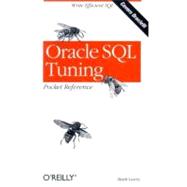
Note: Supplemental materials are not guaranteed with Rental or Used book purchases.
Purchase Benefits
As a database administrator on a financial IMS project about eight years ago, Mark Gurry was asked to investigate his company's database direction for the next five years. The number of users was up to 950, the cost of maintaining the mainframes was huge, and he'd heard about relational databases and downsizing. After much investigation, he chose Oracle, and has stuck with the system ever since. He has worked as Manager of Computing and Network Services, senior database administrator, senior Oracle technical support, and other jobs. He now has a small consulting company called New Age Consultants. Mark has worked for many large organizations and is currently working for Telecom Australia, the largest computer site in Australia and one of the largest in the world. He has also spoken on tuning at Oracle user group meetings and has given internal tuning courses at several of his larger client sites. He has been a senior team member on award-winning systems that have been developed using Oracle.
| Introduction | p. 1 |
| The SQL Optimizers | p. 4 |
| Understanding the Rule-Based Optimizer | p. 5 |
| Understanding the Cost-Based Optimizer | p. 11 |
| Some Common Optimizer Misconceptions | p. 19 |
| Which Optimizer to Use? | p. 19 |
| Rule-Based Optimizer Problems and Solutions | p. 20 |
| Incorrect Driving Table | p. 21 |
| Incorrect Index | p. 22 |
| Incorrect Driving Index | p. 23 |
| Using the Order By Index and not the Where Index | p. 25 |
| Cost-Based Optimizer Problems and Solutions | p. 26 |
| The Skewness Problem | p. 26 |
| Analyzing with Wrong Data | p. 29 |
| Mixing the Optimizers in Joins | p. 31 |
| Choosing an Inferior Index | p. 33 |
| Joining Too Many Tables | p. 36 |
| Incorrect Init. Ora Parameter Settings | p. 38 |
| Problems Common to Rule and Cost with Solutions | p. 43 |
| Statement Not Written for Indexes | p. 43 |
| Indexes Are Missing or Inappropriate | p. 47 |
| Use of Single-Column Index Merge | p. 50 |
| Misuse of Nested Loop, Sort Merge, or Hash Join | p. 51 |
| Misuse of in, Exists, Not in, Not Exists, or Table Joins | p. 54 |
| Unnecessary Sorts | p. 59 |
| Too Many Indexes on a Table | p. 61 |
| Use of Or Instead of Union | p. 63 |
| Tables and Indexes with Many Deletes | p. 64 |
| Other Problems: Heavy Usage of Views | p. 66 |
| Other Problems: Joining Too Many Tables | p. 67 |
| Handy SQL Tuning Tips | p. 67 |
| Identify Bad SQL | p. 67 |
| Identify Long-Running SQL Statements | p. 68 |
| Use Decode for If/Else Selection | p. 69 |
| Encourage Bind Variables | p. 70 |
| Using SQL Hints | p. 72 |
| When Are Hints Ignored? | p. 73 |
| Using Hints in Views | p. 74 |
| Available Hints | p. 74 |
| Using DBMS_STATS to Manage Statistics | p. 94 |
| Using DBMS_STATS to Analyze Faster | p. 94 |
| Copying Statistics Using DBMS_STATS | p. 95 |
| Manipulating Statistics Using DBMS_STATS | p. 96 |
| Reverting to Previous Statistics | p. 97 |
| Using Outlines for Consistent Execution Plans | p. 98 |
| Recording Outlines | p. 98 |
| Enabling Outlines | p. 100 |
| Managing Outlines | p. 101 |
| Table of Contents provided by Syndetics. All Rights Reserved. |
The New copy of this book will include any supplemental materials advertised. Please check the title of the book to determine if it should include any access cards, study guides, lab manuals, CDs, etc.
The Used, Rental and eBook copies of this book are not guaranteed to include any supplemental materials. Typically, only the book itself is included. This is true even if the title states it includes any access cards, study guides, lab manuals, CDs, etc.